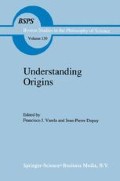Abstract
This article is written as a prolegomena, both to a research program, and a forthcoming book discussing the same issues in greater detail (Kauffman, 1991). The suspicion that evolutionary theory needs broadening is widespread. To accomplish this, however, will not be easy. The new framework I shall discuss here grows out of the realization that complex systems of many kinds exhibit high spontaneous order. This implies that such order is available to evolution and selective forces for further molding. But it also implies, quite profoundly, that the spontaneous order in such systems may enable, guide and limit selection. Therefore, the spontaneous order in complex systems implies that selection may not be the sole source of order in organisms, and that we must invent a new theory of evolution which encompasses the marriage of selection and self-organization.
Access this chapter
Tax calculation will be finalised at checkout
Purchases are for personal use only
Preview
Unable to display preview. Download preview PDF.
References
Anderson, P. W.: 1987, ‘Spin glass Hamiltonians: a bridge between biology, statistical mechanics and computer science’, in: Emerging Syntheses in Science, D. Pines (Ed.), Addison-Wesley.
Dyson, F.: 1985, Origins of Life. London: Cambridge University Press.
Eigen, M.: 1987, ‘Macromolecular evolution: dynamical ordering in sequence space’, in: Emerging Syntheses in Science, D. Pines (Ed.), Addison-Wesley.
Eigen, M. and Schuster, P.: 1979, The Hypercycle. New York: Heidelberg: Springer Verlag.
Ewens, W. J.: 1979, Mathematical Population Genetics. New York: Heidelberg: Springer Verlag.
Gillespie, J. H.: 1974, Theor. Population Biol. 44, 167.
Hopfield, J. J.: 1982, ‘Neural networks and physical systems with emergent collective computational abilities’, Proc. Natl. Acad. Sci. 79, 254.
Kauffman, S.: 1969, ‘Metabolic stability and epigenesis in randomly constructed genetic nets’, J. Theor. Biol., 22, 437.
Kauffman, S.: 1974, ‘The large scale structure and dynamics of gene control circuits: an ensemble approach’, J. Theor. Biol. 44, 167.
Kauffman, S.: 1984, ‘Emergent properties in random complex automata’, Physica, 10D, 145.
Kauffman, S.: 1986, ‘Autocatalytic sets of proteins’, J. Theor. Biol., 119, 1.
Kauffman, S.: 1991, Origins of Order and Self-organisation in Evolution, New York: Oxford Univ. Press.
Kauffman, S. and Levin, S.: 1987, ‘Towards a general theory of adaptation on rugged fitness landscapes’, J. Theor. Biol. 128, 11.
Kauffman, S. and Smith, R. G.: 1986, ‘ Adaptive automata based on Darwinian selection’, in: Farmer, Lapedes Packard and Wendroff (eds.), Evolution, Games and Learning. Models for Adaptation in Machines and Nature. Amsterdam: North Holland.
Kirkpatrick, S., Gelatt, C. D., Jr., and Vechi, M. P.: 1983, ‘Optimization by simulated annealing’, Science, 220, 671.
Lin, S. and Kernighan, B. W.: 1973, ‘An effective heuristic algorithm for the travelling salesman problem’, Oper. Res., 21, 498.
Rossler, O.: 1974, ‘Chemical automata in homogeneous and reaction diffusion kinetics’, Notes in Biomath., B4, 399.
Smith, John Maynard: 1970, ‘Natural selection and the concept of a protein space’, Nature, 225, 563.
Wright, S.: 1932, ‘The roles of mutation, inbreeding, crossbreeding, and selection in evolution’, in: Proc. 6th International Congress on Genetics, Vol. I, p. 356.
Author information
Authors and Affiliations
Editor information
Editors and Affiliations
Rights and permissions
Copyright information
© 1992 Springer Science+Business Media Dordrecht
About this chapter
Cite this chapter
Kauffman, S.A. (1992). Origins of Order in Evolution: Self-Organization and Selection. In: Varela, F.J., Dupuy, JP. (eds) Understanding Origins. Boston Studies in the Philosophy and History of Science, vol 130. Springer, Dordrecht. https://doi.org/10.1007/978-94-015-8054-0_8
Download citation
DOI: https://doi.org/10.1007/978-94-015-8054-0_8
Publisher Name: Springer, Dordrecht
Print ISBN: 978-90-481-4090-9
Online ISBN: 978-94-015-8054-0
eBook Packages: Springer Book Archive

